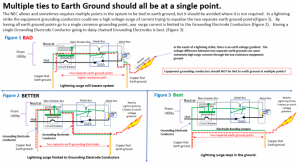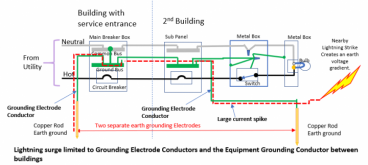Having said that, from what I understand it is done that way in some countries.
This might be of interest:
Having said that, from what I understand it is done that way in some countries.
I'm reading this with much interest. I have just finished building my first battery and connected it to the inverter and SCC for testing purposes. The plan was to connect an electric vehicle charger to the battery to charge the vehicle from the battery. Well, that failed because the EV charger says "Ground fault. Check wiring". The new battery system is totally off grid though and has no connection to any existing installation in my workshop.
The inverter is a Xijia 3000W and has two terminals for AC and a ground stud next to it. I grounded the stud to a sub board which is grounded to a earth rod just outside. This is all new cabling and working for other circuits. So ground, better call it earth, is all good.
I also opened the inverter and found the earth stud only connects to the earth pin of the socket. Nothing else.
To make the system work I need to create a new, separate TN-S system as we use here in Australia. This is for the inverter AC side to run RCDs
View attachment 35581
So I got in contact with Xijia and asked for advice. Well, they said the AC contacts are floating and have no connection to any earth or grounding and also cannot be grounded (no reason provided). If I measure, I have AC60V and AC48V between the AC contact and earth. But I guess this is just a floating potential and not really a voltage difference where current flows.
Seems like these inverters work but cannot be used for any sensitive loads or devices which actually check for safety, like the EV charger or medical equipment. And the manufacturer said I cannot create a new MEN link at the AC output... Has anyone tried?
So, is a new inverter the only option here? I much appreciate your feedback on this...
I would word that slightly differently:In a TN-S system you do not have a connection/bond between the Earth and the Neutral.
I don't know what the rules are in other countries, but I would advise to only do this at the service entrance if the rules allow it.You can (and should) add your own local earth to the Neutral cable tough. But not to the utility Earth.
It is called MEN - multiple earthed neutral.
I would word that slightly differently:
" In a TN-S system you do not have a connection/bond between the Earth and the Neutral at the customer premise. "
There will be a bond at the utility transformer. That is what creates the low impedance path for clearing any shorts/faults to the non-conducting metal (Here in the states these are called ground faults.... but I do not like that name because it is not related to earth ground).
I don't know what the rules are in other countries, but I would advise to only do this at the service entrance if the rules allow it.
Doing it in multiple places is begging for problems in a lightning strike.
That is a good thing!!Here is the rule if these rods are less than 20m away then you HAVE TO connect them directly to each other.
So if you have a shed 25m away then the rod you put down there does not need to be directly connected to the main rod.



So the logical question is "Why do they have us do another ground rod for the second building if it can create this large current spike?"
The answer is that you can also have a high energy, high frequency spike imposed on the wiring due to electro-magnetic pulse from the lightning (or other sources). If there is a long wire to the ground rod the natural impedance would block the high frequency spike from 'draining'. So.... which scenario is the worse? The voltage gradient across the earth causing a spike or the EMP from the lightning causing the spike? Clearly, the rules bodies think the earth voltage gradient is less of a problem. I have my questions about it but presumably they know more than I do.
My point is this: Be aware of the potential problems and try to avoid both if you can. Don't add a ground rod that creates the problem if you don't have to. More is not always better when it comes to grounding schemes.
There are minimum resistance requirements here as well. (I think the max is 25ohms) In fact a lot of inspectors just require a 2nd ground rod even before it is measured. The other thing to keep in mind is that the contact resistance of a ground rod can and often does change over time. Even if the rod(s) measure 20 ohms, there is a reasonable probability it will be different (often more ) a year later.But, you need a good ground.
If your rod is in a dry sand or rocky soil then its resistance will be too high. Utility will not accept it here. Ground resistance measurement is mandatory too.
Protect you from what? (that is a serious question)And if it is too high it can not protect you enough.
I can see that. If there is no neutral back to the transformer, the only path is through the earth. The path through earth will probably be in the 20-25ohm range and putting a 25 ohm resistor in the path of high current is going to create a large voltage drop.1, neutral cable break. All you have is your own local ground. In that case all your equipments chassis will be under current in your house (high current devices will stop working ... the common error users report: that the washing machine is not starting)
There are minimum resistance requirements here as well. (I think the max is 25ohms) In fact a lot of inspectors just require a 2nd ground rod even before it is measured. The other thing to keep in mind is that the contact resistance of a ground rod can and often does change over time. Even if the rod(s) measure 20 ohms, there is a reasonable probability it will be different (often more ) a year later.
Protect you from what? (that is a serious question)
I can see that. If there is no neutral back to the transformer, the only path is through the earth. The path through earth will probably be in the 20-25ohm range and putting a 25 ohm resistor in the path of high current is going to create a large voltage drop.
Thinking about the wiring here in the states, if the neutral from the utility was lost, we would have a similar situation where the ground system could become the path back to the transformer..... but I have not heard of that happening much.


